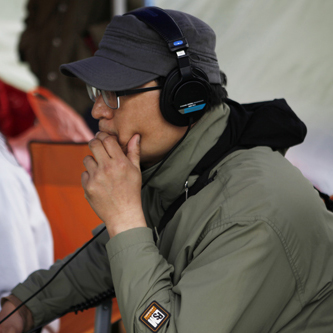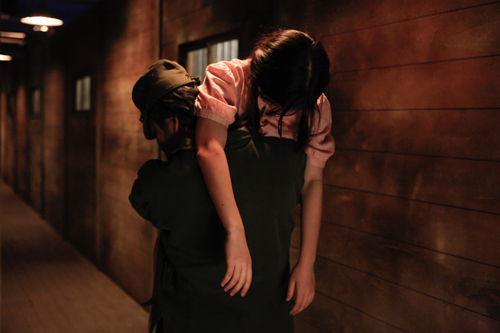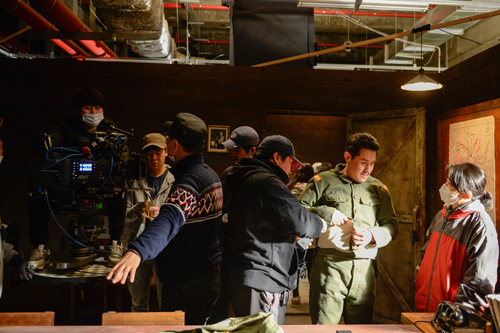18th(2016)
- Opening Film (9)
- New Currents (39)
- 120 Years of French Women’s Cinema, 1896-2016: from Alice Guy-Blaché to New Generation (27)
- Polemics: Comfort Women - Memory, Commemoration and Films (6)
- Queer Rainbow (11)
- Asian Short Film & Video Competition (19)
- I-TEENS (7)
- Documentary Ock Rang Award (1)
- Barrier Free Screening (1)
- A Woman Judge, 1962X2016 (1)
- In Memory of Chantal Akerman: Nowhere and Everywhere (4)
Spirits\' Homecoming
CHO Jung-rae
- Korea
- 2015
- 127min
- DCP
- color
- Fiction
Violence Body
SYNOPSIS
SYNOPSIS
In 1943, an ingenuous 14-year-old girl, Jeong-min is
taken away from her family by Japanese army. Jeongmin
is accompanied with lots of other girls including
Young-hee who also is brought in a train whose
destination is unknown to the girls. Jeong-min and
other girls are thrown out into the middle of a freezing
battle field of World War II. What awaits them is the
site filled with miserable pain and agony forged by
Japanese soldiers.
Program Note
named Jeong-min (Kang Ha-na) is drawn to a strange place by the Imperial
Japanese Army without even knowing why, and, from that time, she is forced to
live a horrendous life as a sex salve in Japanese military brothels. In 1991,
South Korea, Eun-kyeong (Choe Ri) is sexually assaulted by a recently
discharged criminal, and witnesses the death of her father and the perpetrator
who fight against each other in front of her very eyes. Her shock makes her into
a psychic, and she becomes connected to the painful space and time in which
Jeong-min is shackled, able to hear her voice.
Spirit\'s
Homecoming line-height:115%;mso-ascii-font-family:\" 맑은=\"\" 고딕\";mso-ascii-theme-font:major-latin;=\"\" mso-fareast-font-family:\"맑은=\"\" 고딕\";mso-fareast-theme-font:major-latin;mso-hansi-font-family:=\"\" \"맑은=\"\" 고딕\";mso-hansi-theme-font:major-latin\"=\"\"> depicts women’s lives in the face of
sexual assault, hovering between the last days of Japanese Empire and the
present day through the act of spiritual calming. In this sense, the spiritual calming
in this film represents the symbolic meaning of the ‘Statue of Peace,’ which
the Japanese government is trying to take down. The shadow of a girl with her
fists clenched in the statue looks like that of an elderly woman, and the
butterfly of hope flies upon the chest of the shadow, which stands for the
official apology from the Japanese government, and an institutional settlement
of the pain. Connecting the present with the past, and survivors with victims,
the statue shows the will for spiritual healing through the act of remembering
the past. This film is also the story of healing made possible by the encounter
of the dead and the living.
line-height:115%;mso-ascii-font-family:\" 맑은=\"\" 고딕\";mso-ascii-theme-font:major-latin;=\"\" mso-fareast-font-family:\"맑은=\"\" 고딕\";mso-fareast-theme-font:major-latin;mso-hansi-font-family:=\"\" \"맑은=\"\" 고딕\";mso-hansi-theme-font:major-latin\"=\"\">An unexpected box office smash hit, this
film was one of the biggest issues in the South Korean film industry during the
first half of 2016. Its total audience reached 3.5 million under the communal
anger aroused by the December 28th ‘irreversible agreement.’ The audience’s
support for this film sheds a clear light on the necessity to endeavor for a just
solution between the Japanese and South Korean governments, instead of the
communal creation of a scapegoat from the victims of the Japanese Imperial Military’s
‘Comfort Women.’ [Jay SOHN]
PROGRAM NOTE
SYNOPSIS
In 1943, an ingenuous 14-year-old girl, Jeong-min is
taken away from her family by Japanese army. Jeongmin
is accompanied with lots of other girls including
Young-hee who also is brought in a train whose
destination is unknown to the girls. Jeong-min and
other girls are thrown out into the middle of a freezing
battle field of World War II. What awaits them is the
site filled with miserable pain and agony forged by
Japanese soldiers.
Program Note
named Jeong-min (Kang Ha-na) is drawn to a strange place by the Imperial
Japanese Army without even knowing why, and, from that time, she is forced to
live a horrendous life as a sex salve in Japanese military brothels. In 1991,
South Korea, Eun-kyeong (Choe Ri) is sexually assaulted by a recently
discharged criminal, and witnesses the death of her father and the perpetrator
who fight against each other in front of her very eyes. Her shock makes her into
a psychic, and she becomes connected to the painful space and time in which
Jeong-min is shackled, able to hear her voice.
Spirit\'s
Homecoming line-height:115%;mso-ascii-font-family:\" 맑은=\"\" 고딕\";mso-ascii-theme-font:major-latin;=\"\" mso-fareast-font-family:\"맑은=\"\" 고딕\";mso-fareast-theme-font:major-latin;mso-hansi-font-family:=\"\" \"맑은=\"\" 고딕\";mso-hansi-theme-font:major-latin\"=\"\"> depicts women’s lives in the face of
sexual assault, hovering between the last days of Japanese Empire and the
present day through the act of spiritual calming. In this sense, the spiritual calming
in this film represents the symbolic meaning of the ‘Statue of Peace,’ which
the Japanese government is trying to take down. The shadow of a girl with her
fists clenched in the statue looks like that of an elderly woman, and the
butterfly of hope flies upon the chest of the shadow, which stands for the
official apology from the Japanese government, and an institutional settlement
of the pain. Connecting the present with the past, and survivors with victims,
the statue shows the will for spiritual healing through the act of remembering
the past. This film is also the story of healing made possible by the encounter
of the dead and the living.
line-height:115%;mso-ascii-font-family:\" 맑은=\"\" 고딕\";mso-ascii-theme-font:major-latin;=\"\" mso-fareast-font-family:\"맑은=\"\" 고딕\";mso-fareast-theme-font:major-latin;mso-hansi-font-family:=\"\" \"맑은=\"\" 고딕\";mso-hansi-theme-font:major-latin\"=\"\">An unexpected box office smash hit, this
film was one of the biggest issues in the South Korean film industry during the
first half of 2016. Its total audience reached 3.5 million under the communal
anger aroused by the December 28th ‘irreversible agreement.’ The audience’s
support for this film sheds a clear light on the necessity to endeavor for a just
solution between the Japanese and South Korean governments, instead of the
communal creation of a scapegoat from the victims of the Japanese Imperial Military’s
‘Comfort Women.’ [Jay SOHN]
Director
-

CHO Jung-raeCHO Jung-rae
Born in 1973, from Cheongsong, Gyeongbuk South Korea. Attended Daegu Highschool and has a bachelor in Cinematography from Chungang University. Since his debut in French Cote Film Festival with film Jong-gi, his graduation project, he produced over 50 documentaries and animations. In 2012, his feature film of traditional Korean Chorus Duresori was directed and produced through ‘Myung Film’. The movie Foulball, documentary of an independent baseball team, with three years of picturing, has been released in 2015. Furthermore, since 2001, he performed as Korean traditional drummer. Through these activities, he was able to meet Comfort Women Victims.
Credit
- Producer임성철 LIM Seong-chul
- Cast 손숙 SON Suk 최리 CHOI Lee 황화순 HWANG Hwa-sun 서미지 SEO Mi-ji
- Screenwriter 조정래 CHO Jung-rae
- Cinematography 강상협 KANG Sang-hyup
- Art director 임원철 LIM Won-chul
- Editor 박민선 PARK Min-sun
- Music 함현상 HAM Hyun-sang
- Sound 김정숙 KIM Jung-suk



